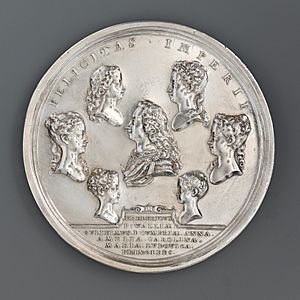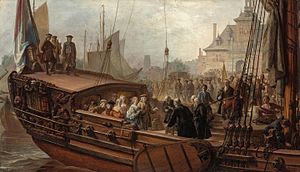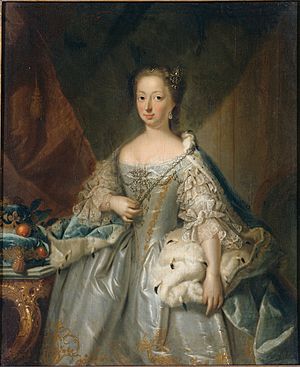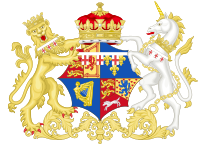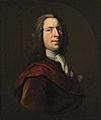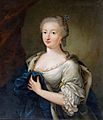Anne, Princess Royal and Princess of Orange facts for kids
Quick facts for kids Anne |
|
|---|---|
| Princess Royal | |
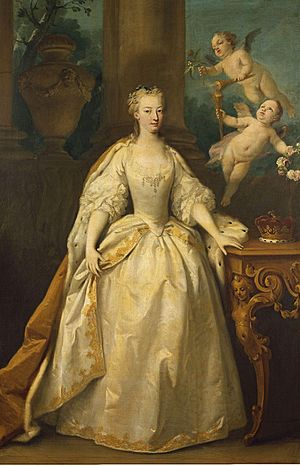
Portrait by Jacopo Amigoni, c. 1734
|
|
| Princess consort of Orange | |
| Tenure | 25 March 1734 - 22 October 1751 |
| Born | 2 November 1709 (O.S.: 22 October 1709) Herrenhausen Palace, Hanover, Electorate of Hanover, Holy Roman Empire |
| Died | 12 January 1759 (aged 49) The Hague, Dutch Republic |
| Burial | 23 February 1759 Nieuwe Kerk, Delft |
| Spouse | |
| Issue | Carolina, Princess of Nassau-Weilburg Princess Anna William V, Prince of Orange |
| House | Hanover |
| Father | George II of Great Britain |
| Mother | Caroline of Ansbach |
Anne, Princess Royal and Princess of Orange (2 November 1709 – 12 January 1759) was the second child and oldest daughter of King George II of Great Britain and his wife, Caroline of Ansbach. She married William IV, Prince of Orange. He was the first leader of all seven parts of the Northern Netherlands.
Anne was in charge of the Netherlands from 1751 until she died in 1759. She had a lot of power because she was ruling for her young son, William V. She loved English culture and her family connections there. However, she could not convince the Dutch to join Britain in the Seven Years' War. Princess Anne was the second daughter of a British ruler to be called Princess Royal. In the Netherlands, people called her Anna van Hannover.
Contents
Early Life of Princess Anne
Anne was born at Herrenhausen Palace in Hanover. This was five years before her grandfather, George Louis, became King George I of Great Britain and Ireland. She was named after her grandfather's cousin, Anne, Queen of Great Britain.
Anne learned German, French, and English. She also had music lessons from Georg Friedrich Händel, a famous composer. Händel usually did not like teaching. But he said he would "make the only exception for Anne, flower of princesses." She always supported him, going to his operas and buying his music.
In 1720, Anne got smallpox but survived. Two years later, her mother helped make a new way to prevent smallpox popular. It was called variolation, an early type of immunisation. This method had been seen in Turkey by Lady Mary Wortley Montagu.
To test it, six prisoners who were going to be executed were given the chance to try variolation instead. They all lived. Six orphan children also got the treatment and survived. Because of this, the Queen had her two younger daughters, Amelia and Caroline, treated successfully. Anne's face was scarred by smallpox. She was not seen as pretty as her younger sisters.
On August 30, 1727, King George II gave his oldest daughter the title Princess Royal. This title had not been used since King Charles I gave it to his daughter Mary in 1642.
Princess Anne's Marriage
In 1725, people thought about Anne marrying King Louis XV of France. This marriage could have helped France stay neutral with the Netherlands and Prussia. It also could have protected France from Spain. But their different religions caused problems.
Anne would have had to become Catholic. But there were worries that even this would not be enough for the Pope. The plan was dropped when the French insisted Anne become a Roman Catholic.
On March 25, 1734, Anne married William IV, Prince of Orange at St. James's Palace. After her marriage, she stopped using her British title and used her new Dutch title. The music played at her wedding was called This is the day. Handel wrote the music to Anne's own words, based on parts of the Psalms.
Handel also wrote an opera called Parnasso in Festa for her wedding. It was performed for the first time on March 13, 1734, and was very successful. Nassau Street in London was named after her marriage.
William had a problem with his spine, which changed his looks. But Anne said she would marry him even "if he were a baboon." She really wanted to get married. She did not want to live as an unmarried woman at her father's court. William was her only choice for a Protestant prince.
After their wedding, William and Anne sailed to Holland. They lived in Leeuwarden. Anne soon missed her home when William went to fight in the Rhineland. She went back to England because she thought she was pregnant. She wanted her child to be born in England since it would be in line for the British throne.
However, her husband and father were not happy with this. They told her to go back to Holland after a short visit. By April 1735, it was clear Anne was not pregnant. In 1736, she did become pregnant, but the baby was stillborn.
The Dutch people did not like Anne very much. She also did not get along with her mother-in-law, Marie Louise of Hesse-Kassel. Anne was seen as very royal, but she seemed to think British people were better than Dutch people. She was also thought to ignore her duties. She seemed to only care about music and books.
People said she was not kind to her helpers. For example, she made her ladies-in-waiting read to her for hours, even if they were tired. At first, her relationship with William was distant. But it grew into a close and loving one, which you can see in their letters.
In 1747, William became the leader of all Seven United Provinces. This led to a change that made his new power something that could be passed down in his family. William and Anne moved to The Hague. Anne invited Handel to the Netherlands in 1750, bringing his music there.
Anne's Time as Regent
William IV died on October 22, 1751, when he was forty years old. Anne was chosen to be in charge for her three-year-old son, William V. She had all the powers that a hereditary leader of the Netherlands usually had. The only thing she did not do was military duties. These were given to Duke Louis Ernest of Brunswick-Lüneburg.
Anne worked hard, but she was also proud and bossy. This made people dislike her. In the 1750s, there was growing tension and business competition between Holland and Great Britain. This put Anne in a difficult spot.
Anne's main goal in her own country was to protect the power of the central government. This government was now hereditary (passed down in the family). This was a new idea and caused arguments after her husband died. But Anne successfully kept the central government strong. For example, she stopped the city of Haarlem from holding its election by not releasing the list of candidates. People did not like her strict rule, but her strong actions helped make the new hereditary leadership secure in the Netherlands.
In her foreign policy, Anne preferred to be allies with Britain and the Emperor, rather than France. This was not popular in the Netherlands. Her efforts to strengthen the southern provinces against the French Netherlands also met with much disagreement.
Anne continued to be regent until she died from dropsy (a medical condition) in 1759. She died in The Hague. After her death, her mother-in-law, Marie Louise of Hesse-Kassel, took over as regent. She was helped by Duke Louis Ernest of Brunswick-Lüneburg. When Marie Louise also died in 1765, Anne's daughter, Carolina, became regent. She ruled until William V turned eighteen in 1766.
Legacy
Princess Anne, Maryland, a town in the United States, is named after her.
Arms
On January 31, 1719, Anne was given the right to use the royal family's coat of arms. As a grandchild of the king, her arms had a special white stripe with five red crosses. On August 30, 1727, as a child of the king, her arms changed to a white stripe with three red crosses.
|
|
Issue
| Name | Birth | Death | Notes |
|---|---|---|---|
| Princess Carolina | 28 February 1743 | 6 May 1787 | married 5 March 1760, Charles Christian, Prince of Nassau-Weilburg; had children |
| Princess Anna | 15 November 1746 | 29 December 1746 | |
| William V, Prince of Orange | 8 March 1748 | 9 April 1806 | married 4 October 1767, Princess Wilhelmina of Prussia; had children |
Images for kids
See also
 In Spanish: Ana de Hannover para niños
In Spanish: Ana de Hannover para niños


